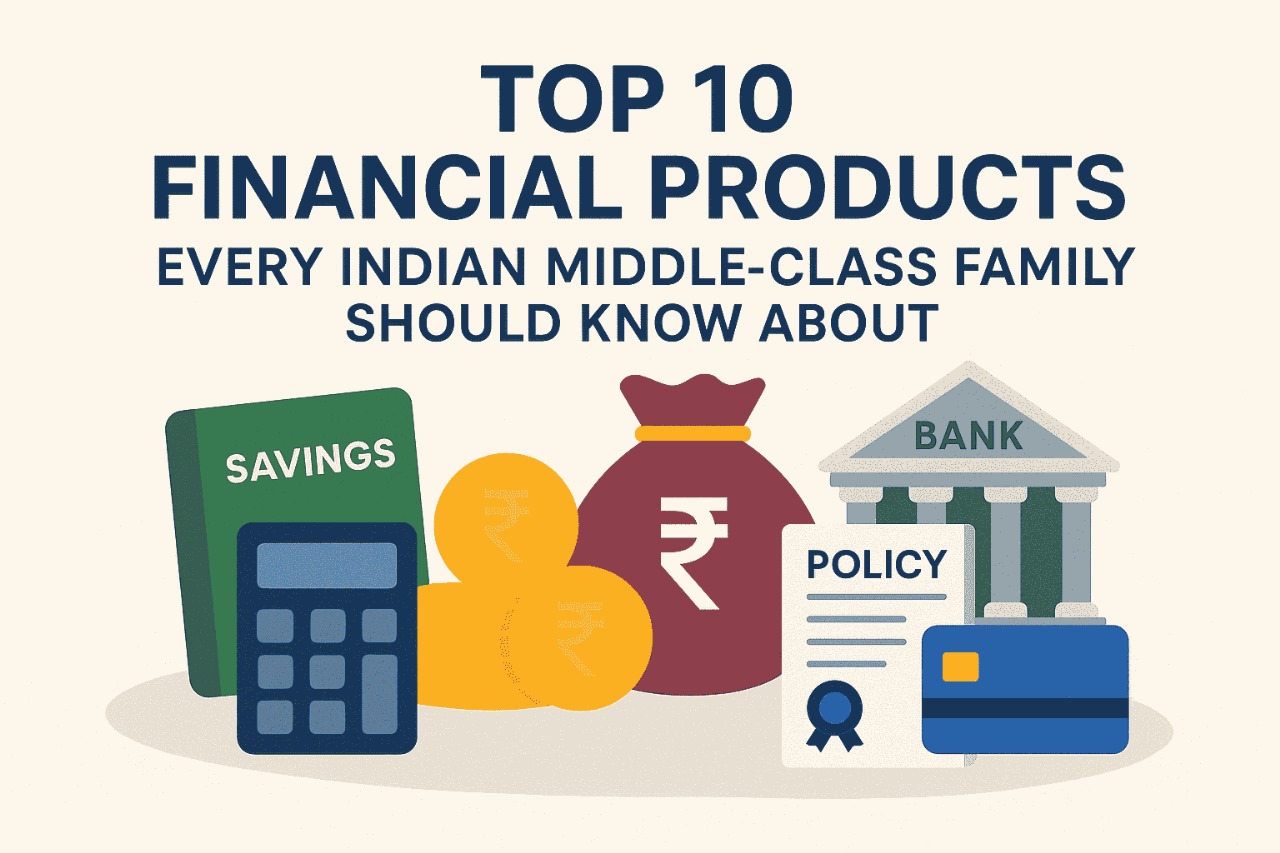Managing money wisely is a crucial skill for the Indian middle class, especially in an era of rising expenses and economic uncertainty. With the right financial products, families can build wealth, secure their future, and achieve major life goals such as owning a home, educating children, and retiring comfortably.
According to a 2024 survey by the Reserve Bank of India, over 53% of urban middle-class households rely on formal financial instruments for savings and investments — a clear sign of growing awareness. Yet, many families still struggle to identify the right mix of products. This article explores the top 10 financial products that every Indian middle-class family should be aware of and consider using.
Top 10 Financial Products
1. Savings Account
A basic yet essential financial product, a savings account offers security and liquidity for your money. Most banks now offer accounts with zero balance requirements, digital banking, and auto sweep-in FD features. While interest rates (around 2.5% to 4%) aren’t high, the ease of access makes it a must-have for daily transactions and emergency funds.
2. Fixed Deposits (FDs)
FDs are one of the most popular financial products among Indian families. They offer guaranteed returns, flexibility in tenures, and safety, especially for conservative investors. As of mid-2025, many banks are offering interest rates between 6.5% and 7.5% on FDs for 1–3 year tenures.
While FDs don’t beat inflation over the long term, they are a reliable short- to medium-term investment.
3. Public Provident Fund (PPF)
The PPF is a government-backed long-term saving scheme offering tax-free returns and up to ₹1.5 lakh deduction under Section 80C. The current interest rate is 7.1% (Q2 FY 2025-26), revised quarterly by the Ministry of Finance.
With a 15-year lock-in, it’s ideal for retirement planning or long-term wealth building, particularly for risk-averse investors.
4. Systematic Investment Plans (SIPs) in Mutual Funds
SIPs are one of the best financial products for disciplined wealth accumulation. You can invest as low as ₹500 monthly in mutual funds and benefit from rupee-cost averaging and power of compounding.
According to AMFI (Association of Mutual Funds in India), SIP contributions crossed ₹20,000 crore in May 2025, reflecting growing investor interest. For middle-class families, SIPs in large-cap or hybrid funds can be a smart route to beating inflation and growing wealth over time.
5. Term Life Insurance
A term insurance policy provides high coverage at a low premium, securing your family’s financial future in case of untimely death. Unlike traditional policies, term plans don’t offer maturity benefits, but they ensure peace of mind.
Experts recommend coverage of 10–15 times your annual income. For a healthy 30-year-old, a ₹1 crore cover may cost just ₹8,000 to ₹10,000 annually.
6. Health Insurance
Health emergencies can drain years of savings. A dedicated health insurance plan helps cover hospitalization, critical illness, and other medical expenses. Opt for a family floater plan with at least ₹10–15 lakh coverage, especially in metro cities.
A 2023 NITI Aayog report revealed that nearly 30% of middle-class Indians remain uninsured, despite the rising costs of private healthcare. Investing in a good policy is a financial necessity, not a luxury.
7. National Pension System (NPS)
The NPS is a voluntary retirement savings product backed by the Indian government. It offers market-linked returns and additional tax benefits (extra ₹50,000 under Section 80CCD(1B)).
For middle-class employees, especially in the private sector, NPS is a smart addition to EPF or PPF, ensuring post-retirement income with partial annuity and lump sum withdrawals after 60.
8. Recurring Deposits (RDs)
RDs allow you to invest a fixed amount every month for a fixed tenure, similar to SIPs but in a bank deposit. They are ideal for short-term savings goals like buying a gadget, planning a vacation, or creating a festival fund.
Banks offer interest rates similar to FDs, usually between 6% and 7%, depending on tenure and institution.
9. Gold ETFs or Sovereign Gold Bonds (SGBs)
Instead of buying physical gold, middle-class families can now invest in Gold Exchange-Traded Funds (ETFs) or SGBs, which offer transparency, liquidity, and storage safety.
SGBs also offer 2.5% annual interest on the invested amount, along with tax-free capital gains on maturity. With gold remaining a culturally significant asset, these digital options are gaining popularity.
10. Credit Cards (with Caution)
While often misused, credit cards can be a valuable financial product when used responsibly. They help build a credit score, offer rewards and cashbacks, and assist in managing emergency purchases.
Opt for cards with low annual fees, fuel or utility benefits, and ensure dues are paid in full each month to avoid interest charges and debt traps.
Which financial product do you prefer most?
The Indian middle class is rapidly evolving, with better access to financial literacy and digital tools. Choosing the right financial products is not about complexity, but about aligning them with your family’s life goals, risk appetite, and future needs.
Whether you’re just starting out or planning for retirement, these ten products form a solid foundation for a resilient and rewarding financial journey. So, which one do you think is the best for you? Share your views in the comments section below.



